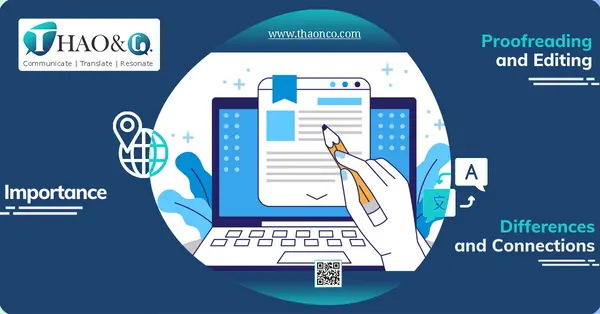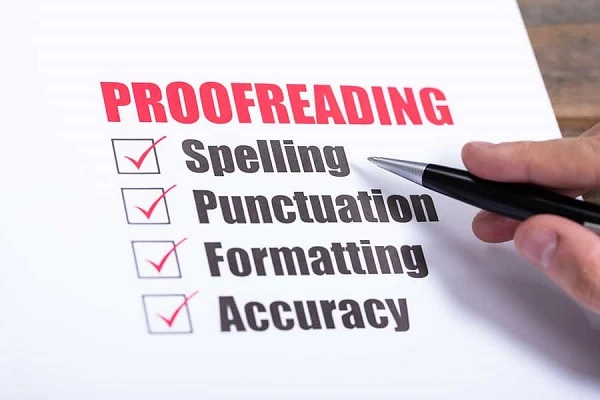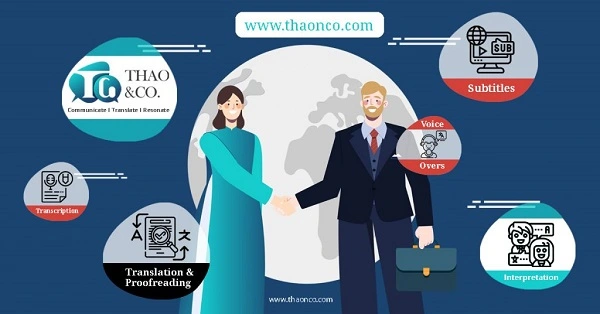Are you looking for high-quality proofreading and editing services to improve your content, but still unsure about the differences between the two concepts?
Then you have come to the right place! In this article, Thao & Co. will clarify the definitions of proofreading and editing to help you distinguish these two processes.
Proofreading and Editing are two important processes in improving the quality of content. Here are some similarities between the two processes:
Are proofreading and editing the same? Although both processes aim to improve the quality of texts, they are executed differently and serve different purposes.

Proofreading aims to detect and correct grammar, structure, and spelling errors in the text. Its primary focus is on the precision of words and sentences and adherence to linguistic standards.
Conversely, editing emphasizes improving the overall flow and structure of the text. This includes making changes that enhance readability, such as additions, deletions, or other modifications to ensure the content is tailored to the purpose of the text and the target audience.
Proofreading is the final stage in the writing process, taking place after all editing steps have been completed and before publishing the text. In this stage, the proofreader meticulously checks every word, sentence, and paragraph to detect any remaining grammar, structure, and spelling errors.
Editing is an important stage that comes before proofreading. During this stage, the editor will evaluate the text as a whole to identify any issues that need to be addressed. This may involve adjusting sentence structures, reorganizing ideas, and altering the writing style and word choice to enhance clarity and readability.
Proofreading is essential to eliminate minor mistakes in completed texts, such as manuscripts, newspaper articles, or publishing materials, ensuring the quality of the final work.
Editing is crucial in all stages of writing, from brainstorming to reviewing the completed texts. Its purpose is to improve the clarity, quality, and overall structure of texts, producing engaging and professional pieces.
Proofreading plays an important role in creating error-free and credible texts. The duty of proofreaders is to carefully examine every element of the text to correct minor errors such as spelling or punctuation and modify inappropriate expressions.
On the other hand, editing is a critical process for making the text more coherent and engaging. It goes beyond merely correcting errors and involves reviewing the whole structure of the text to ensure that its message is effectively conveyed.
The job of editors is to rephrase ambiguous or complex sentences, rearrange ideas, and adjust the writing style and word choice to create a seamless, readable, and engaging piece of text.
Proofreaders and editors are indispensable in the creation of many types of content, such as:
Although serving different purposes, proofreading and editing both play pivotal roles in improving the quality of texts. Proofreading is the final stage of the quality control process, while editing is crucial for enhancing readability and communication value.
In fact, these two processes often occur simultaneously. Proofreading can detect issues that can be solved by editing, and after the editing process, the content will be proofread once again.
Therefore, proofreading and editing have become an essential phase in producing high-quality content. This method is also applied in the revision stage before the final work is presented to the public.
Both proofreading and editing are inarguably essential in guaranteeing the accuracy and communication value of translations. It is imperative to possess excellent localization and research skills to produce translations that truly resonate with the target reader.

Proofreading eliminates trivial errors to make sure that the translation is free of any grammar or spelling mistakes. Editing improves sentence structure and word choice to enhance coherence and readability, thus conveying the original message effectively.
Depending on the type of text, either proofreading or both proofreading and editing may be applied. Normally, the translator and proofreader or editor are different people to ensure objectivity in reviewing for the best outcome.
Proofreading is typically applied for documents in which the structures must remain the same, such as:
On the other hand, materials that allow more flexibility and creativity call for both proofreading and editing, for example:
However, it is essential that the edited version remains faithful to the source text, maintaining its original meaning, format, and information structure.
Imagine you are a translator who has just received an English translation of a piece of text. Before delivering the final work to the client, the translation must go through a revision stage to ensure it is completely accurate.
If you are proofreading, you will carefully check each word, sentence, and paragraph to correct any errors, such as word choice, spelling, or punctuation. For example:
If you are editing, you will make necessary adjustments to improve the clarity and coherence of the translation. This job is not limited to correcting trivial errors but also includes reviewing the whole structure of the text to make sure it is coherent and readable.
Changes in sentence structure, information organization, and word choice can be made. For example:
Thao & Co. is a reputable translation company offering high-quality Translation and Proofreading services for various types of documents.

Regardless of the complexity of your content, we are here to handle every translation and deliver completely accurate texts that meet all of your requirements.
Here are some advantages of choosing Thao & Co. services:
We hope this article has provided useful information about proofreading and editing, and the differences between these two processes. Overall, both proofreading and editing are crucial for improving the quality and communication values of written content.
Are you looking for high-quality language services? Contact Thao & Co. right away to experience top-notch services and receive professional translations for your documents.